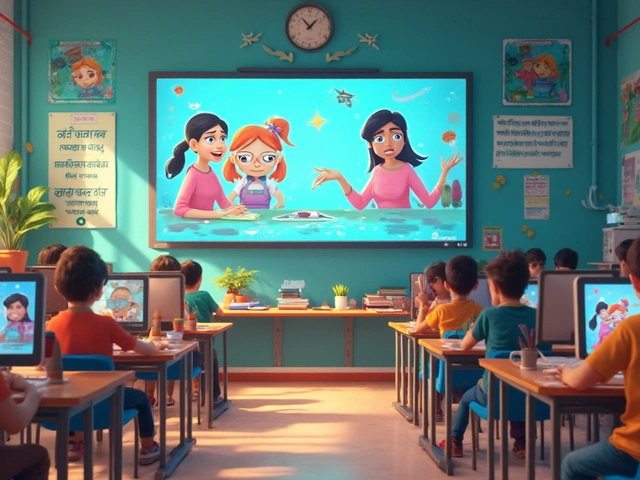Ever wondered why some online courses keep you hooked while others feel like endless slideshows you can’t wait to escape? It isn’t magic. It’s about how they handle three things: People, Process, and Product. That’s what experts call the ‘three P’s of eLearning’. Without these, digital learning turns into a boring chore. With them, it becomes memorable, powerful—even life changing. Let’s look at what these three P’s mean in the real world, why they matter, and how you can use them whether you’re a student, a teacher, or someone designing online content.
People: The Real Drivers of eLearning
Forget fancy platforms and high-end animations for a second. People are the core of any eLearning experience. That means learners, instructors, subject matter experts, and even the support folks who make sure you can log in when you forget your password at midnight.
In India, as of 2024, more than 85 million students enrolled in online learning courses, according to AISHE. But actual engagement depends on how the course creators understand the needs, motivations, and challenges of these people. Take for example, a 17-year-old JEE aspirant from Jaipur isn’t going to have the same learning style as a working parent in Bangalore upskilling on weekends. Personalisation matters.
Course designers who care about people pay attention to diversity, accessibility, and motivation. They experiment with polls, real-life scenarios, and group activities. Many top Indian edtech firms (like Byju’s and Vedantu) have found that student retention increases by over 40% when learners receive personalized feedback, shout-outs during sessions, and interactive discussions—not just pre-recorded lectures.
Instructors are also ‘people’, not robots reading slides. The most engaging facilitators make themselves available for conversations, break the ice in virtual rooms, and understand how hard it is to ask a question in a group chat. In a 2023 LinkedIn Learning survey, 58% of learners said that a responsive, “visible” instructor kept them enrolled through to the last module.
Let’s not forget parents or guardians in younger learners’ journeys. When schools in Bangalore moved online during the 2020-21 pandemic, most kids under 12 needed an adult at home to help troubleshoot or just keep them focused. Good eLearning systems also support these ‘learning partners’ with clear guides and updates.
Here are some people-focused eLearning tips:
- Keep communication lines open—use chat, voice, video, and discussion threads.
- Look for student feedback and actually use it to tweak sessions.
- Make space for peer learning: group tasks, forums, buddy systems.
- Don’t ignore students with limited data/internet access—offer downloadable resources or lighter web versions of content.
Process: Building the Pathway for Learning
Think of the Process as the engine under the hood. It’s everything involved in designing, developing, delivering, and maintaining eLearning. Processes make sure there’s a clear roadmap, so people don’t waste time figuring out what to do next. Without a smart process, even great content falls flat.
A good process starts with finding out exactly what learners need to achieve—like cracking NEET, getting certified in Python, or building confidence in English speaking. Clearly defined outcomes mean you can work backwards to design each module, quiz, and assignment.
In eLearning, “chunking” information matters. Nobody likes staring at 60-minute videos with no breaks or quizzes. Breaking lessons into 5-to-10 minute interactive “micro-units” improves completion rates by up to 52%, as shown in a 2024 Coursera study. This is especially true for mobile learners, who now make up over 60% of India’s online students.
Smooth processes also help instructors. Scheduling automated reminders, setting up self-grading quizzes, or using progress dashboards take away a lot of manual work. Platforms like Moodle, used by major universities such as IIT Bombay and IGNOU, use these tools to keep thousands of students on track without chaos.
Processes also guard against chaos on the tech side. A single sign-on, clear instructions for each assessment, and backup plans for tech failure (like keeping WhatsApp numbers handy for notification) all matter more than most people realize—at least, when things go wrong.
Quick process tips:
- Map learner goals to every lesson and activity.
- Send weekly updates so no one feels lost.
- Keep instructions clear and steps minimal for tasks and assignments.
- Automate reminders and grading where possible.
- Pilot new courses with a small group, collect feedback, and make quick fixes.
| Process Feature | Completion Rate | Dropout Reason if Missing |
|---|---|---|
| Micro-unit Modules | 75% | Overwhelming content load |
| Automated Reminders | 66% | Forgetting deadlines |
| Progress Dashboards | 70% | Lack of task clarity |
| Live Q&A Sessions | 62% | Unanswered learner questions |

Product: Crafting What Learners Actually Use
The Product is the final learning package—videos, reading material, practice tests, coding sandboxes, or anything learners interact with. The best processes and people mean little if what you deliver isn’t user-friendly, relevant, and engaging.
A good eLearning Product is never a badly filmed Zoom class uploaded with an “it’ll do” attitude. It’s thoughtfully created for the chosen audience. For coding classes, learners get hands-on practice and instant feedback. English language learners find interactive pronunciation tools, bite-sized grammar quizzes, and real-time speaking practice rooms. The ‘Product’ adapts to different subjects and ages.
A 2024 KPMG India report showed that 83% of learners who dropped out of online courses did so due to confusing navigation, outdated content, or mobile-unfriendly design—not because the subject was too tough. That’s how critical the ‘Product’ is.
To build an awesome eLearning Product:
- Use clear menus and simple navigation—don’t bury key lessons in subfolders.
- Pick the right formats: Use video only when visuals add real value. Go for podcasts or text when attention is low.
- Make it interactive: Polls, scenario-based questions, and ‘choose your adventure’ activities keep people alert.
- Add lots of practice: Gamified quizzes, coding playgrounds, and immediate feedback keep learning sticky.
- Keep mobile users in mind: India leads the world in mobile-first learners, and clunky sites chase them away.
The table below gives an idea of what makes a great eLearning product and how it links to learner success:
| Product Feature | Impact on Success Rate (%) |
|---|---|
| Mobile-responsive Design | +30 |
| Regular Content Updates | +25 |
| Interactive Assessments | +22 |
| Practical Real-life Scenarios | +18 |
How to Implement the Three P’s in Your eLearning Journey
You don’t have to be a giant edtech company to put the three P’s into action. Whether you’re a solo teacher, a college professor, or a parent setting up your child’s online school routine, these principles apply.
Start with People. Make a WhatsApp group for students. Set up mini Zoom catchup calls if you sense someone is drifting. Don’t ignore language barriers. If your students prefer Hindi but the material’s in English, offer summaries or guidance in both. Tech is cool, but people matter more.
When it comes to Process, plan small and adapt fast. Don’t create a 6-month mega-course and hope for the best. Roll out shorter, weekly units. Listen to early feedback and fix quickly. Use Google Forms, WhatsApp quizzes, or Moodle for setup—they’re free and reliable.
About the Product, borrow from the best. Plenty of platforms offer free templates for mobile-friendly design, gamified quizzes, or video instructions. Don’t over-pack lessons; focus on “one idea per session.” If learners can’t find resources in two clicks, rethink your structure.
And it’s not all about academic topics. The three P’s work for art workshops, soft skills bootcamps, or adult literacy drives in rural India. During the lockdown, one NGO in Karnataka used voice notes and simple text-based quizzes to boost adult literacy among women who’d never used the internet before. People: trusted community mentor. Process: weekly calls with checklists. Product: WhatsApp voice and text. Simple, but it worked.

The Three P’s: Future Trends for Better eLearning
Now that AI, AR/VR, and chatbots are everywhere, do the three P’s still make sense? Actually, they matter even more.
AI can help personalize learning at scale, but only if people design it to be inclusive and fair. With AR/VR, process planning becomes trickier—someone still needs to guide learners on how to use headsets, troubleshoot, or ensure that visuals don’t distract from core content.
Crowdsourced content and student-driven “micro-courses” are getting popular. In 2025, short, peer-taught modules on platforms like Unacademy or Skillshare grew by 28% compared to last year. Here, anyone can become a teacher or course creator, but the same three P’s decide which courses stand out. Even if you’re running a free YouTube channel, think about who your audience is (People), how you’ll structure your uploads (Process), and whether your material is easy to use on any device (Product).
Now, some experts say we might see a fourth or fifth ‘P’ in coming years. Platforms and Policy are possibilities, as more government regulations come for online assessments and accessibility. But for now, nailing the three P's of eLearning gives you the best shot at making online education work. Whether you’re a student slogging at midnight, a teacher juggling lesson plans from home, or just curious about digital learning—keep these three P’s in mind. They’re what decide whether you just survive eLearning, or actually thrive with it.



